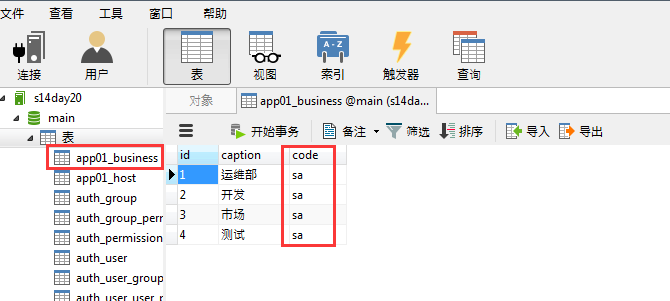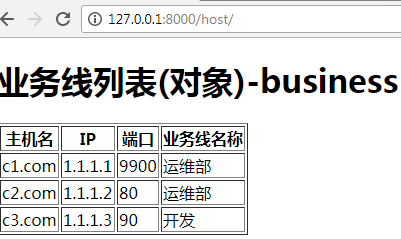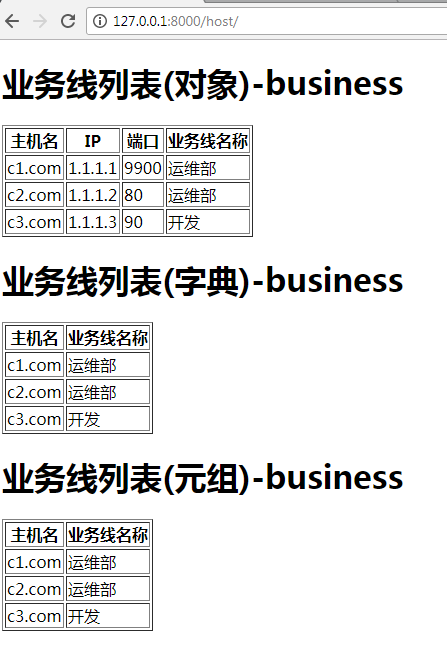Day20-单表中获取表单数据的3种方式
1. 搭建环境请参考:http://www.cnblogs.com/momo8238/p/7508677.html
2. 创建表结构
models.py
from django.db import models
# Create your models here. class Business(models.Model):
#id列,是自动创建的
caption=models.CharField(max_length=32) class Host(models.Model):
nid=models.AutoField(primary_key=True)
hostname=models.CharField(max_length=32,db_index=True) #加上索引,可以提高查询速度
ip=models.GenericIPAddressField(protocol="ipv4",db_index=True)
port=models.IntegerField()
b=models.ForeignKey("Business",to_field='id')
在Terminal端执行:
python manage.py makemigrations
python manage.py migrate
3. 在SQLite中打开.

4. 在business业务线数据表中,手动增加几条数据

5. 如果此时想再往 business表中增加一列的话,会报错。因为程序不知道该怎么给已经存在的数据赋这列值。code=models.CharField(max_length=32)
或者可以在新建的时候写上null=True; code=models.CharField(max_length=32,null=True)
或者可以在新建的时候写上default="sa"; code=models.CharField(max_length=32,default="sa")

选1,增加默认值"sa", 重新打开一下表,就可以看到更新了。


导入相应的模块,from app01 import models (这里的意思是导入models.py这个模块)

6.在business表中,测试在单表中获取数据的三种方式。QuerySet就像一个列表,只不过里面存放的是很多对象。
记忆:只要出现values,那么里面存放的就是字典;
只要出现values_list,那么里面存放的就是列表;
除此之外,其它的都是对象。
下面获取到的都是QuerySet对象。
v1 = models.Business.objects.all()
#QuerySet类型,里面存放的是对象。[obj(id,caption,code),obj,obj] v2 = models.Business.objects.all().values('id','caption')
# QuerySet类型,里面存放的是字典[{'id':1,'caption':'运维部'},{'id':1,'caption':'开发部'}..] v3 = models.Business.objects.all().values_list('id', 'caption')
# QuerySet类型,里面存放的是元组[(1,'运维部'),(2,'开发部').....]
如果想获取一个对象,可以用以下的方法。
models.Business.objects.get(id=1) #如果不存在的花,则会报错。
models.Business.objects.filter(id=1) #获取到的是一个对象列表,如果没有匹配的值,返回的列表就为空。但不会报错。
models.Business.objects.filter(id=1).first() #获取对象列表中的第一个值。

粘贴部分程序
urls.py
from django.conf.urls import url
from django.contrib import admin
from app01 import views
urlpatterns = [
url(r'^admin/', admin.site.urls),
url(r'^business/', views.business),
]
views.py
from django.shortcuts import render,HttpResponse
from app01 import models
# Create your views here. def business(request):
v1 = models.Business.objects.all()
#QuerySet类型,里面存放的是对象。[obj(id,caption,code),obj,obj] v2 = models.Business.objects.all().values('id','caption')
# QuerySet类型,里面存放的是字典[{'id':1,'caption':'运维部'},{'id':1,'caption':'开发部'}..] v3 = models.Business.objects.all().values_list('id', 'caption')
# QuerySet类型,里面存放的是元组[(1,'运维部'),(2,'开发部').....] return render(request,'business.html',{'v1':v1,'v2':v2,'v3':v3})
business.html
<!DOCTYPE html>
<html lang="en">
<head>
<meta charset="UTF-8">
<title>Title</title>
</head>
<body>
<h1>业务线列表(对象)-business</h1>
{% for row in v1 %}
<li>{{row.id}} - {{row.caption}} - {{row.code}}</li>
{% endfor %} <h1>业务线列表(字典)-business</h1>
{% for row in v2 %}
<li>{{row.id}} - {{row.caption}}</li>
{% endfor %} <h1>业务线列表(元组)-business</h1>
{% for row in v3 %}
<li>{{row.0}} - {{row.1}}</li>
{% endfor %}
</body>
</html>
models.py
from django.db import models
# Create your models here. class Business(models.Model):
#id列,是自动创建的
caption=models.CharField(max_length=32)
code=models.CharField(max_length=32) class Host(models.Model):
nid=models.AutoField(primary_key=True)
hostname=models.CharField(max_length=32,db_index=True) #加上索引,可以提高查询速度
ip=models.GenericIPAddressField(protocol="ipv4",db_index=True)
port=models.IntegerField()
b=models.ForeignKey("Business",to_field='id')
网页中的效果:

7. 手动在app01_host表中增加数据备用

8. 稍做测试,看下row.b_id, row_b 分别输出的是什么
row.b_id:是数字
row_b:是business object 对象

row:属于Host object对象
row.b:属于Business object 对象

既然row.b属于Business object 对象,那么它后面就可以再通过. 去获取它下面的属性和方法

插播一句:
所有的变量都是对象。 对象在python里,其实是一个指针,指向一个数据结构,数据结构里有属性,有方法。
9. 在前端输出所有信息
host.html中
<!DOCTYPE html>
<html lang="en">
<head>
<meta charset="UTF-8">
<title>Title</title>
</head>
<body>
<h1>业务线列表(对象)-business</h1>
<table border="1">
<thead>
<tr>
<th>主机ID</th>
<th>主机名</th>
<th>IP</th>
<th>端口</th>
<th>业务线ID</th>
<th>业务线名称</th>
<th>业务线编码</th>
</tr>
</thead>
<tbody>
{% for row in v1%}
<tr>
<td>{{row.nid}}</td>
<td>{{row.hostname}}</td>
<td>{{row.ip}}</td>
<td>{{row.port}}</td>
<td>{{row.b_id}}</td>
<td>{{row.b.caption}}</td>
<td>{{row.b.code}}</td>
</tr>
{% endfor %} </tbody>
</table> </body>
</html>
效果图:

优化输出,隐藏了主机ID和业务线ID
<!DOCTYPE html>
<html lang="en">
<head>
<meta charset="UTF-8">
<title>Title</title>
</head>
<body>
<h1>业务线列表(对象)-business</h1>
<table border="1">
<thead>
<tr> <th>主机名</th>
<th>IP</th>
<th>端口</th>
<th>业务线名称</th>
</tr>
</thead>
<tbody>
{% for row in v1%}
<tr hid="{{row.nid}}" bid="{{row.b_id}}">
<td>{{row.hostname}}</td>
<td>{{row.ip}}</td>
<td>{{row.port}}</td>
<td>{{row.b.caption}}</td>
</tr>
{% endfor %} </tbody>
</table> </body>
</html>
效果图:

10. 一对多表操作,也就是跨表操作。通过.可以实现跨表,通过__也可以实现跨表操作,不过两者的使用场景不同。
from django.shortcuts import render,HttpResponse
from app01 import models
# Create your views here. def business(request):
v1 = models.Business.objects.all()
#QuerySet类型,里面存放的是对象。[obj(id,caption,code),obj,obj] v2 = models.Business.objects.all().values('id','caption')
# QuerySet类型,里面存放的是字典[{'id':1,'caption':'运维部'},{'id':1,'caption':'开发部'}..] v3 = models.Business.objects.all().values_list('id', 'caption')
# QuerySet类型,里面存放的是元组[(1,'运维部'),(2,'开发部').....] return render(request,'business.html',{'v1':v1,'v2':v2,'v3':v3}) def host(request):
v1=models.Host.objects.filter(nid__gt=0) #nid>0,其实代表的是所有数据
# for row in v1:
# print(row.b)
# print(row.b.caption,row.b.code,sep='\t')
# return HttpResponse("Host")
v2 = models.Host.objects.filter(nid__gt=0).values('nid','hostname','b_id','b__caption')
#QuerySet:[{}]
print(v2)
return render(request, 'host.html', {'v1': v1})

10.2

用字典的方法,让前端获取到数据

总结3种跨表方式
views.py
from django.shortcuts import render,HttpResponse
from app01 import models
# Create your views here. def business(request):
v1 = models.Business.objects.all()
#QuerySet类型,里面存放的是对象。[obj(id,caption,code),obj,obj] v2 = models.Business.objects.all().values('id','caption')
# QuerySet类型,里面存放的是字典[{'id':1,'caption':'运维部'},{'id':1,'caption':'开发部'}..] v3 = models.Business.objects.all().values_list('id', 'caption')
# QuerySet类型,里面存放的是元组[(1,'运维部'),(2,'开发部').....] return render(request,'business.html',{'v1':v1,'v2':v2,'v3':v3}) def host(request):
v1=models.Host.objects.filter(nid__gt=0) #nid>0,其实代表的是所有数据
# for row in v1:
# print(row.b)
# print(row.b.caption,row.b.code,sep='\t')
# return HttpResponse("Host")
v2 = models.Host.objects.filter(nid__gt=0).values('nid','hostname','b_id','b__caption')
#QuerySet:[{}]
for row in v2:
print(row['nid'],row['hostname'],row['b_id'],row['b__caption']) v3 = models.Host.objects.filter(nid__gt=0).values_list('nid', 'hostname', 'b_id', 'b__caption') return render(request, 'host.html', {'v1': v1,'v2':v2,'v3':v3})
host.html
<!DOCTYPE html>
<html lang="en">
<head>
<meta charset="UTF-8">
<title>Title</title>
</head>
<body>
<h1>业务线列表(对象)-business</h1>
<table border="1">
<thead>
<tr>
<th>主机名</th>
<th>IP</th>
<th>端口</th>
<th>业务线名称</th>
</tr>
</thead>
<tbody>
{% for row in v1%}
<tr hid="{{row.nid}}" bid="{{row.b_id}}">
<td>{{row.hostname}}</td>
<td>{{row.ip}}</td>
<td>{{row.port}}</td>
<td>{{row.b.caption}}</td>
</tr>
{% endfor %}
</tbody>
</table> <h1>业务线列表(字典)-business</h1>
<table border="1">
<thead>
<tr>
<th>主机名</th>
<th>业务线名称</th>
</tr>
</thead>
<tbody>
{% for row in v2%}
<tr hid="{{row.nid}}" bid="{{row.b_id}}">
<td>{{row.hostname}}</td>
<td>{{row.b__caption}}</td>
</tr>
{% endfor %} </tbody>
</table> <h1>业务线列表(元组)-business</h1>
<table border="1">
<thead>
<tr>
<th>主机名</th>
<th>业务线名称</th>
</tr>
</thead>
<tbody>
{% for row in v3%}
<tr hid="{{row.0}}" bid="{{row.2}}">
<td>{{row.1}}</td>
<td>{{row.3}}</td>
</tr>
{% endfor %}
</tbody>
</table>
</body>
</html>
页面效果:

11.一对多表操作的3种方式总结


把host页的名称都改为主机列表

12. 增加一对多的数据
为了使输出的数据更好看,我们增加一列命名为序号。在for循环下有个计数器
<td>{{forloop.counter}}</td>,循环几次,则值就相应地显示为几,可以跟着数据库中的数据进行动态调整。
<td>{{forloop.counter0}}</td>,从0开始计数(0.1.2.3.)
<td>{{forloop.revcounter}}</td>,倒着计数计数直到1(3.2.1)
<td>{{forloop.revcounter0}}</td>,倒着计数计数直到0(3.2.1.0)
<td>{{forloop.first}}</td>,是否是第一次循环,是的话返回True,否则返回False
<td>{{forloop.last}}</td>,是否是最后一次循环,是的话返回True,否则返回False
<td>{{forloop.parentloop}}</td>,当有多层循环的时候,拿到父亲是属于第几次循环。
host.html中程序修改如下:
<!DOCTYPE html>
<html lang="en">
<head>
<meta charset="UTF-8">
<title>Title</title>
</head>
<body>
<h1>主机列表(对象)-business</h1>
<table border="1">
<thead>
<tr>
<th>序号</th>
<th>主机名</th>
<th>IP</th>
<th>端口</th>
<th>业务线名称</th>
</tr>
</thead>
<tbody>
{% for row in v1%}
<tr hid="{{row.nid}}" bid="{{row.b_id}}">
<td>{{forloop.counter}}</td>
<td>{{row.hostname}}</td>
<td>{{row.ip}}</td>
<td>{{row.port}}</td>
<td>{{row.b.caption}}</td>
</tr>
{% endfor %}
</tbody>
</table> <h1>主机列表(字典)-business</h1>
<table border="1">
<thead>
<tr>
<th>主机名</th>
<th>业务线名称</th>
</tr>
</thead>
<tbody>
{% for row in v2%}
<tr hid="{{row.nid}}" bid="{{row.b_id}}">
<td>{{row.hostname}}</td>
<td>{{row.b__caption}}</td>
</tr>
{% endfor %} </tbody>
</table> <h1>主机列表(元组)-business</h1>
<table border="1">
<thead>
<tr>
<th>主机名</th>
<th>业务线名称</th>
</tr>
</thead>
<tbody>
{% for row in v3%}
<tr hid="{{row.0}}" bid="{{row.2}}">
<td>{{row.1}}</td>
<td>{{row.3}}</td>
</tr>
{% endfor %}
</tbody>
</table>
</body>
</html>
显示效果:

13. 用模态对话框实现增加一条数据。
urls.py
from django.conf.urls import url
from django.contrib import admin
from app01 import views
urlpatterns = [
url(r'^admin/', admin.site.urls),
url(r'^business/', views.business),
url(r'^host/', views.host),
]
business.html
<!DOCTYPE html>
<html lang="en">
<head>
<meta charset="UTF-8">
<title>Title</title>
</head>
<body>
<h1>业务线列表(对象)-business</h1>
{% for row in v1 %}
<li>{{row.id}} - {{row.caption}} - {{row.code}}</li>
{% endfor %} <h1>业务线列表(字典)-business</h1>
{% for row in v2 %}
<li>{{row.id}} - {{row.caption}}</li>
{% endfor %} <h1>业务线列表(元组)-business</h1>
{% for row in v3 %}
<li>{{row.0}} - {{row.1}}</li>
{% endfor %}
</body>
</html>
host.html
<!DOCTYPE html>
<html lang="en">
<head>
<meta charset="UTF-8">
<title>Title</title>
<style>
.hide{
display:none;
}
.shade{
position:fixed;
top:0;
bottom:0;
right:0;
left:0;
background:black;
opacity:0.6;
z-index:100;
}
.add-modal{
position:fixed;
height:300px;
width:400px;
top:100px;
left:50%;
z-index:101;
border:1px solid red;
background:white;
margin-left:-200px;
}
</style>
</head>
<body>
<h1>主机列表(对象)-business</h1>
<div>
<input id="add_host" type="button" value="添加"/> </div>
<table border="1">
<thead>
<tr>
<th>序号</th>
<th>主机名</th>
<th>IP</th>
<th>端口</th>
<th>业务线名称</th>
</tr>
</thead>
<tbody>
{% for row in v1%}
<tr hid="{{row.nid}}" bid="{{row.b_id}}">
<td>{{forloop.counter}}</td>
<td>{{row.hostname}}</td>
<td>{{row.ip}}</td>
<td>{{row.port}}</td>
<td>{{row.b.caption}}</td>
</tr>
{% endfor %}
</tbody>
</table> <h1>主机列表(字典)-business</h1>
<table border="1">
<thead>
<tr>
<th>主机名</th>
<th>业务线名称</th>
</tr>
</thead>
<tbody>
{% for row in v2%}
<tr hid="{{row.nid}}" bid="{{row.b_id}}">
<td>{{row.hostname}}</td>
<td>{{row.b__caption}}</td>
</tr>
{% endfor %} </tbody>
</table> <h1>主机列表(元组)-business</h1>
<table border="1">
<thead>
<tr>
<th>主机名</th>
<th>业务线名称</th>
</tr>
</thead>
<tbody>
{% for row in v3%}
<tr hid="{{row.0}}" bid="{{row.2}}">
<td>{{row.1}}</td>
<td>{{row.3}}</td>
</tr>
{% endfor %}
</tbody>
</table> <div class="shade hide"></div>
<div class="add-modal hide">
<form method="POST" action="/host/">
<div class="group">
<input type="text" placeholder="主机名" name="hostname"/>
</div> <div class="group">
<input type="text" placeholder="IP" name="ip"/>
</div> <div class="group">
<input type="text" placeholder="端口" name="port"/>
</div> <div class="group">
<select name="b_id">
{% for op in b_list %}
<option value="{{op.id}}">{{op.caption}}</option>
{% endfor %} </select>
</div> <input type="submit" value="提交"/>
<input id="cancel" type="button" value="取消"/>
</form>
</div> <script src="/static/jquery-1.12.4.js"></script>
<script>
$(function(){
$('#add_host').click(function(){
$('.shade,.add-modal').removeClass('hide');
});
$('#cancel').click(function(){
$('.shade,.add-modal').addClass('hide');
});
})
</script> </body>
</html>
views.py
from django.shortcuts import render,HttpResponse,redirect
from app01 import models
# Create your views here. def business(request):
v1 = models.Business.objects.all()
#QuerySet类型,里面存放的是对象。[obj(id,caption,code),obj,obj] v2 = models.Business.objects.all().values('id','caption')
# QuerySet类型,里面存放的是字典[{'id':1,'caption':'运维部'},{'id':1,'caption':'开发部'}..] v3 = models.Business.objects.all().values_list('id', 'caption')
# QuerySet类型,里面存放的是元组[(1,'运维部'),(2,'开发部').....] return render(request,'business.html',{'v1':v1,'v2':v2,'v3':v3}) # def host(request):
# v1=models.Host.objects.filter(nid__gt=0) #nid>0,其实代表的是所有数据
# # for row in v1:
# # print(row.b)
# # print(row.b.caption,row.b.code,sep='\t')
# # return HttpResponse("Host")
# v2 = models.Host.objects.filter(nid__gt=0).values('nid','hostname','b_id','b__caption')
# #QuerySet:[{}]
# for row in v2:
# print(row['nid'],row['hostname'],row['b_id'],row['b__caption'])
#
# v3 = models.Host.objects.filter(nid__gt=0).values_list('nid', 'hostname', 'b_id', 'b__caption')
#
# return render(request, 'host.html', {'v1': v1,'v2':v2,'v3':v3}) def host(request):
if request.method=='GET':
v1=models.Host.objects.filter(nid__gt=0) #nid>0,其实代表的是所有数据
v2 = models.Host.objects.filter(nid__gt=0).values('nid','hostname','b_id','b__caption')
v3 = models.Host.objects.filter(nid__gt=0).values_list('nid', 'hostname', 'b_id', 'b__caption')
b_list=models.Business.objects.all()
return render(request, 'host.html', {'v1': v1,'v2':v2,'v3':v3,'b_list':b_list})
elif request.method=='POST':
h=request.POST.get('hostname')
i = request.POST.get('ip')
p = request.POST.get('port')
b = request.POST.get('b_id')
models.Host.objects.create(hostname=h,ip=i,port=p,b_id=b)
return redirect('/host/')
models.py
from django.db import models
# Create your models here. class Business(models.Model):
#id列,是自动创建的
caption=models.CharField(max_length=32)
code=models.CharField(max_length=32) class Host(models.Model):
nid=models.AutoField(primary_key=True)
hostname=models.CharField(max_length=32,db_index=True) #加上索引,可以提高查询速度
ip=models.GenericIPAddressField(protocol="ipv4",db_index=True)
port=models.IntegerField()
b=models.ForeignKey("Business",to_field='id')
最终效果

Day20-单表中获取表单数据的3种方式的更多相关文章
- Struts2中获取HttpServletRequest,HttpSession等的几种方式
转自:http://www.kaifajie.cn/struts/8944.html package com.log; import java.io.IOException; import java. ...
- Activity启动过程中获取组件宽高的五种方式
第一种:(重写Activity的onWindowFocusChanged方法) /** * 重写Acitivty的onWindowFocusChanged方法 */ @Override public ...
- js中获取页面元素节点的几种方式
<!DOCTYPE html><html lang="en"><head> <meta charset="UTF-8" ...
- Spring框架中获取连接池常用的四种方式
1:DBCP数据源 DBCP类包位于 /lib/jakarta-commons/commons-dbcp.jar,DBCP是一个依赖Jakarta commons-pool对象池机制的数据库连接池,所 ...
- SharePoint中获取当前登录的用户名几种方式
第一种方法: System.Web.HttpContext.Current.User.Identity.Name.ToString();或者: SPContext.Current.Site.OpenW ...
- 在Action中获取表单提交数据
-----------------siwuxie095 在 Action 中获取表单提交数据 1.之前的 Web 阶段是提交表单到 Servlet,在其中使用 Request 对象 的方法获取数据 2 ...
- koa 基础(十)原生node.js 在 koa 中获取表单提交的数据
1.app.js // 引入模块 const Koa = require('koa'); const router = require('koa-router')(); /*引入是实例化路由 推荐*/ ...
- 在Express 中获取表单请求体数据
在Express 中获取表单请求体数据 获取 GET 请求参数 获取 POST 请求体数据 安装 配置 获取 GET 请求参数 Express 内置了一个 API , 可以直接通过 req.query ...
- 在SQL SERVER中获取表中的第二条数据
在SQL SERVER中获取表中的第二条数据, 思路:先根据时间逆排序取出前2条数据作为一个临时表,再按顺时排序在临时表中取出第一条数据 sql语句如下: select top 1 * from(se ...
随机推荐
- FFT&NTT总结
FFT&NTT总结 一些概念 \(DFT:\)离散傅里叶变换\(\rightarrow O(n^2)\)计算多项式卷积 \(FFT:\)快速傅里叶变换\(\rightarrow O(nlogn ...
- 使用iChecker的注意事项
1. 要先引用jquery 2. ichecker分好多主题,每个主题带好几种颜色,在配置的时候最好指定一下. 比如引入了square主题的blue颜色演示,配置项中checkboxClass就写ic ...
- JS基础,课堂作业,健康体重评估
健康体重评估 <script> var sex = prompt("请输入性别:"); var height = parseInt(prompt("请输入身高 ...
- web存储机制(localStorage和sessionStorage)
web存储包括两种:sessionStorage 和 localStorage(都是限定在文档源级别,非同源文档间无法共享) 1.sessionStorage 数据放在服务器上(IE不支持) 严格用于 ...
- textbox的验证
代码如下: textBox1.KeyDown += (a, b) => { if (b.KeyCode == Keys.Enter) { textBox2.Focus(); } }; textB ...
- [Ubuntu] <uptime>命令
uptime 命令 就是查看系统启动时间的,前几个大家应该都很熟悉:当前时间.系统启动时间.正在登陆的用户数 最后的三个数字,分别代表过去 1分钟 5分钟 15分钟 的平均负载(Load Ave ...
- Towards Accurate Multi-person Pose Estimation in the Wild 论文阅读
论文概况 论文名:Towards Accurate Multi-person Pose Estimation in the Wild 作者(第一作者)及单位:George Papandreou, 谷歌 ...
- 【视频编解码·学习笔记】4. H.264的码流封装格式 & 提取NAL有效数据
一.码流封装格式简单介绍: H.264的语法元素进行编码后,生成的输出数据都封装为NAL Unit进行传递,多个NAL Unit的数据组合在一起形成总的输出码流.对于不同的应用场景,NAL规定了一种通 ...
- 用 Python 3 的 async / await 做异步编程
前年我曾写过一篇<初探 Python 3 的异步 IO 编程>,当时只是初步接触了一下 yield from 语法和 asyncio 标准库.前些日子我在 V2EX 看到一篇<为什么 ...
- preg_replace 以及弃用的e
preg_replace (PHP 4, PHP 5) preg_replace — 执行一个正则表达式的搜索和替换 说明¶ mixed preg_replace ( mixed $pattern , ...
